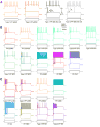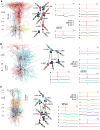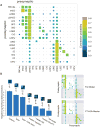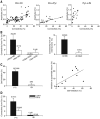Principles of connectivity among morphologically defined cell types in adult neocortex
- PMID: 26612957
- PMCID: PMC4809866
- DOI: 10.1126/science.aac9462
Principles of connectivity among morphologically defined cell types in adult neocortex
Abstract
Since the work of Ramón y Cajal in the late 19th and early 20th centuries, neuroscientists have speculated that a complete understanding of neuronal cell types and their connections is key to explaining complex brain functions. However, a complete census of the constituent cell types and their wiring diagram in mature neocortex remains elusive. By combining octuple whole-cell recordings with an optimized avidin-biotin-peroxidase staining technique, we carried out a morphological and electrophysiological census of neuronal types in layers 1, 2/3, and 5 of mature neocortex and mapped the connectivity between more than 11,000 pairs of identified neurons. We categorized 15 types of interneurons, and each exhibited a characteristic pattern of connectivity with other interneuron types and pyramidal cells. The essential connectivity structure of the neocortical microcircuit could be captured by only a few connectivity motifs.
Copyright © 2015, American Association for the Advancement of Science.
Figures






Comment in
-
Comment on "Principles of connectivity among morphologically defined cell types in adult neocortex".Science. 2016 Sep 9;353(6304):1108. doi: 10.1126/science.aaf5663. Science. 2016. PMID: 27609882
References
Publication types
MeSH terms
Substances
Grants and funding
- T32EY07001/EY/NEI NIH HHS/United States
- F30 MH095440/MH/NIMH NIH HHS/United States
- F30MH095440/MH/NIMH NIH HHS/United States
- DP1 OD008301/OD/NIH HHS/United States
- DP1EY023176/DP/NCCDPHP CDC HHS/United States
- T32EB006350/EB/NIBIB NIH HHS/United States
- P30 EY002520/EY/NEI NIH HHS/United States
- T32 EB006350/EB/NIBIB NIH HHS/United States
- T32 GM007330/GM/NIGMS NIH HHS/United States
- R21 EB016223/EB/NIBIB NIH HHS/United States
- DP1 EY023176/EY/NEI NIH HHS/United States
- DP1OD008301/OD/NIH HHS/United States
- T32 EY007001/EY/NEI NIH HHS/United States
- T32GM007330/GM/NIGMS NIH HHS/United States
- R21EB016223/EB/NIBIB NIH HHS/United States
- P30EY002520/EY/NEI NIH HHS/United States
LinkOut - more resources
Full Text Sources
Other Literature Sources
Miscellaneous

